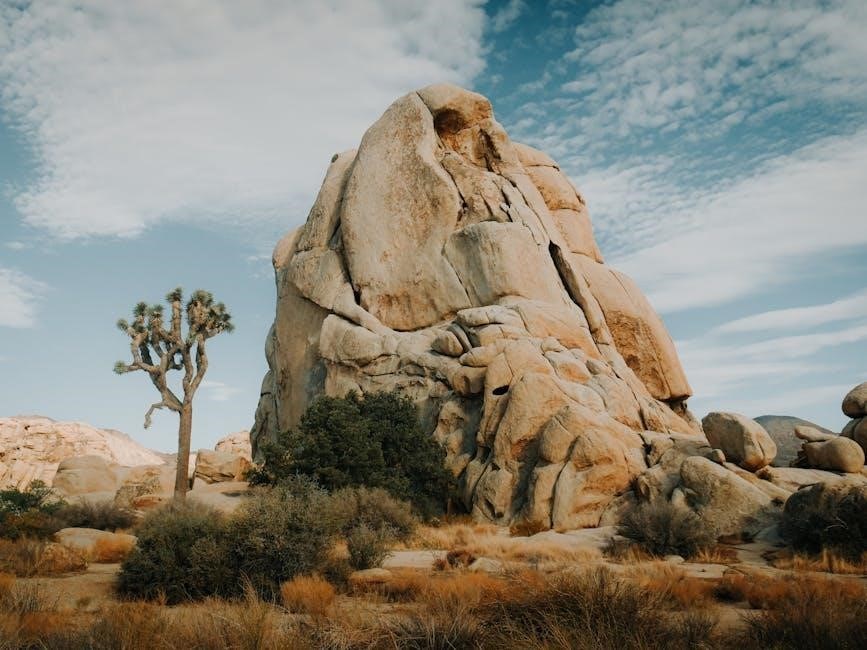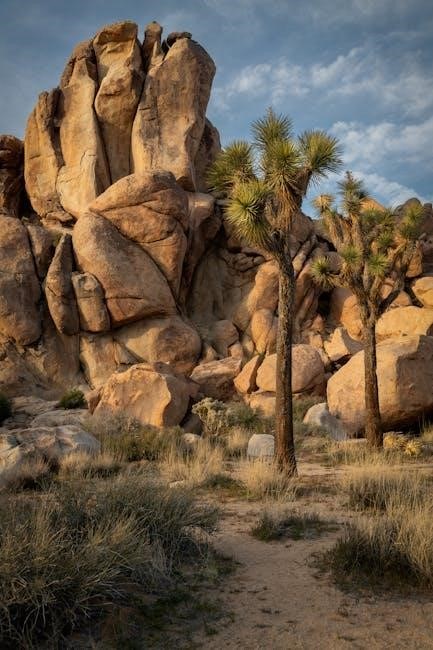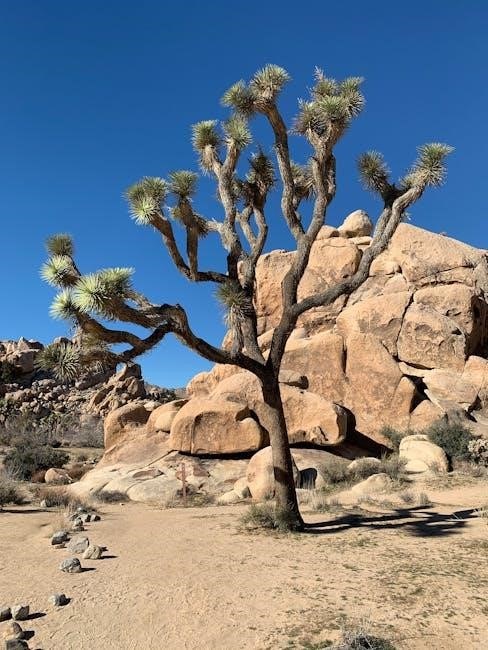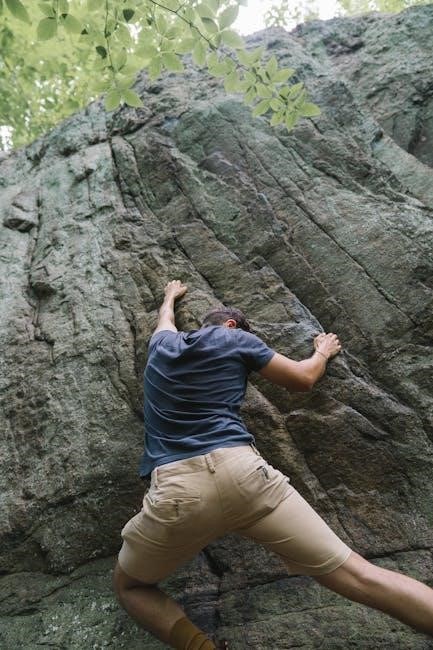Joshua Tree National Park is renowned for its exceptional bouldering opportunities․ With over 2,000 established problems, it offers diverse climbs for all skill levels․ The unique rock formations, scenic desert landscape, and abundant Joshua trees create an inspiring environment for climbers․ Comprehensive guidebooks like Joshua Tree Bouldering by Robert Miramontes provide detailed maps and descriptions to navigate this bouldering paradise effectively․
Overview of Joshua Tree National Park
Joshua Tree National Park is a unique desert landscape known for its stunning monzogranite boulders, iconic Joshua trees, and diverse ecosystems․ Spanning over 800,000 acres, the park offers a blend of Mojave and Colorado Deserts, creating a habitat for a wide variety of flora and fauna․ The park’s rugged terrain, with its massive rock formations and hidden oases, provides endless opportunities for exploration․ Visitors can enjoy hiking, camping, and, of course, world-class bouldering․ The park’s natural beauty and spiritual vibe attract climbers, artists, and nature enthusiasts alike, making it a must-visit destination in Southern California․
Historical Background of Bouldering in Joshua Tree
Bouldering in Joshua Tree has a rich history dating back to the 1960s, when climbers began exploring the park’s unique monzogranite formations․ Early pioneers like John Long and Lynn Hill established iconic problems that set the stage for modern bouldering․ The sport gained popularity in the 1980s with the publication of guidebooks, which documented routes and encouraged climbers to visit․ Today, Joshua Tree is celebrated as one of the world’s premier bouldering destinations, attracting climbers of all skill levels․ Its history reflects a blend of adventure, creativity, and a deep connection to the natural landscape․
Best Bouldering Spots in Joshua Tree
Hidden Valley, Barker Dam, and J-Tree’s iconic monzogranite formations are top destinations․ These areas offer diverse climbs, from beginner-friendly problems to challenging ascents, amidst stunning desert landscapes․
Popular Boulder Formations and Problems
Joshua Tree boasts iconic formations like Hidden Valley, Barker Dam, and Cap Rock․ These areas feature classic problems such as Toe Jam, Hand Jam, and Cafe au Lait, offering climbs for all skill levels․ The park’s unique monzogranite boulders provide friction and intricate features, making them ideal for diverse climbing styles․ Many formations are easily accessible, with clear trails and scenic views․ These popular spots are highlighted in guidebooks like Joshua Tree Bouldering, ensuring climbers can navigate and enjoy the park’s endless opportunities․ The variety of problems and stunning desert backdrop make these formations a must-visit for any boulderer․
Hidden Gems for Experienced Climbers
Experienced climbers seeking lesser-known challenges can explore Joshua Tree’s remote boulder fields․ Areas like the West Side and Wonderland of Rocks offer secluded, high-difficulty problems․ These zones feature complex routes requiring precision and strength, such as Blackwater and Cooler Than the Other Side of the Pillow․ Guidebooks often overlook these gems, making them a true adventure for those willing to venture off the beaten path․ With over 30 square miles of granite formations, Joshua Tree’s hidden corners provide endless opportunities for climbers looking to push their limits in a serene, untouched environment․

Essential Guidebooks for Joshua Tree Bouldering
Joshua Tree Bouldering by Robert Miramontes and The Trad Guide to Joshua Tree are indispensable resources․ These guidebooks offer detailed maps, color photography, and descriptions to navigate JT’s vast bouldering opportunities․
Joshua Tree Bouldering by Robert Miramontes
Joshua Tree Bouldering by Robert Miramontes is the most comprehensive guidebook for bouldering in the park․ It documents over 2,000 problems, ranging from easy to advanced levels․ The book features detailed color photography, maps, and descriptions to help climbers navigate Joshua Tree’s vast granite formations․ Miramontes’ expertise provides insights into the history and evolution of bouldering in the area․ This guide is essential for climbers of all skill levels, offering a wealth of information to explore the park’s iconic boulders and hidden gems․ It remains a must-have resource for anyone planning a bouldering trip to Joshua Tree․
The Trad Guide to Joshua Tree
The Trad Guide to Joshua Tree is a highly regarded resource for climbers seeking traditional routes in the park․ Focused on moderate climbs, it provides detailed maps, directions, and photos to help navigate Joshua Tree’s iconic formations․ This guide is particularly useful for climbers looking to explore classic routes without extreme difficulty․ Its user-friendly format and comprehensive coverage make it a favorite among both locals and visitors․ Whether you’re a seasoned climber or seeking moderate adventures, The Trad Guide offers invaluable insights into Joshua Tree’s rich climbing heritage and diverse terrain․

Safety and Etiquette
Safety and etiquette are crucial in Joshua Tree․ Always use crash pads and spotters, respect the environment, stay on designated trails, and avoid littering․ Climbers should also respect wildlife and other visitors to preserve the park’s natural beauty and ensure a safe experience for everyone․ Adhering to these guidelines helps protect both climbers and the unique ecosystem of Joshua Tree National Park․
Best Practices for Climbing Safety
Always inspect equipment before use and warm up thoroughly to prevent injuries․ Use spotters for dynamic moves and ensure crash pads are properly positioned․ Assess boulder problems carefully, considering difficulty and landing zones․ Stay within your skill level and communicate clearly with climbing partners․ Carry plenty of water and plan for variable desert weather conditions․ Familiarize yourself with park regulations and emergency procedures․ Never climb alone and inform someone of your itinerary․ Respect the environment by staying on designated paths and avoiding damage to vegetation․ Prioritize safety to fully enjoy the unique bouldering experiences Joshua Tree offers while protecting yourself and the park․
Environmental Respect and Regulations
Respecting Joshua Tree’s fragile desert ecosystem is crucial․ Stay on designated trails to avoid damaging vegetation and sensitive habitats․ Never remove or disturb rocks, plants, or wildlife․ Pack out all trash and dispose of waste properly․ Bring enough water to minimize environmental impact․ Follow all park regulations, including no camping in closed areas․ Keep noise levels low to maintain the park’s serene atmosphere․ Avoid using chalk excessively and clean up any spills․ Leave no trace to preserve the natural beauty for future climbers․ Adhering to these guidelines ensures the park remains a pristine destination for bouldering enthusiasts․

Camping and Accommodation
Joshua Tree offers scenic campsites like Jumbo Rocks and Hidden Valley, ideal for bouldering access․ Plan ahead and book early, especially during peak seasons․
Best Campsites for Bouldering Access
Joshua Tree National Park offers several campsites perfect for bouldering enthusiasts․ Jumbo Rocks Campground is a favorite, centrally located near iconic formations like Hidden Valley and Barker Dam․ Skull Rock Campground is another excellent choice, offering easy access to popular bouldering areas․ Indian Cove Campground, known for its secluded sites, is ideal for those seeking quieter surroundings while still being close to key climbing spots․ Reservations are highly recommended, especially during peak seasons, to secure a spot near the park’s world-class bouldering opportunities․
Quick Guide to Camping in J-Tree
For a seamless camping experience in Joshua Tree, plan ahead and book reservations early, especially during peak seasons․ Pack essentials like water, food, and a sturdy camping pad․ Respect the environment by packing out all trash and minimizing your impact․ Choose campsites that align with your climbing goals, ensuring easy access to popular bouldering areas․ Check weather forecasts to prepare for extreme temperatures or unexpected rain․ Familiarize yourself with park rules and regulations to ensure a safe and enjoyable stay․ Camping in J-Tree offers a unique way to immerse yourself in the parks stunning natural beauty and world-class climbing opportunities․

Hiring a Guide
Hiring a certified guide enhances your Joshua Tree bouldering experience․ Guides offer expert knowledge, safety tips, and access to hidden gems, ensuring a memorable and secure adventure․
Professional Climbing Guides in Joshua Tree
Professional climbing guides in Joshua Tree offer expert instruction and unparalleled knowledge of the park’s bouldering terrain․ Services like Cliffhanger Guides and Mojave Guides provide tailored experiences, ensuring safety and fun for climbers of all levels․ Certified guides are well-versed in the park’s unique formations and can lead you to hidden gems and classic routes․ They emphasize environmental respect and safe practices, making them invaluable for both beginners and seasoned climbers․ Hiring a guide enhances your adventure, providing insights into the park’s history and ensuring a memorable experience amidst Joshua Tree’s stunning landscapes․
Benefits of Guided Climbing Tours
Guided climbing tours in Joshua Tree offer numerous benefits, including expert knowledge of the park’s best routes and safety practices․ Guides provide personalized instruction, helping climbers improve techniques and tackle challenging problems․ They also reveal hidden gems and lesser-known bouldering spots, enhancing your adventure․ Additionally, guides emphasize environmental stewardship, ensuring climbers leave minimal impact․ For beginners, guided tours offer a safe introduction to bouldering, while experienced climbers gain new insights and challenges․ Overall, guided tours enrich your climbing experience, combining adventure with education and unforgettable memories in Joshua Tree’s unique landscape․